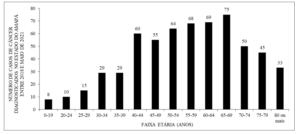ORIGINAL ARTICLE
MENDES, Fabrízio do Amaral [1], RODRIGUES, Rafael Henrique de Andrade [2], SOUZA, Yngrid Sheron Ribeiro de [3], RODRIGUES, Gabriel Vinícius de Andrade [4], DIAS, Claudio Alberto Gellis de Mattos[5], DENDASCK, Carla Viana[6], OLIVEIRA, Euzébio de[7], FECURY, Amanda Alves[8]
DENDASCK, Carla Viana. et al. Quantitative and epidemiological analysis of measles cases in Macapá-AP from 2017 to 2021. Revista Científica Multidisciplinar Núcleo do Conhecimento. Year. 08, Ed. 05, Vol. 01, pp. 93-106. May 2023. ISSN: 2448-0959, Access link: https://www.nucleodoconhecimento.com.br/health/measles-cases, DOI: 10.32749/nucleodoconhecimento.com.br/health/measles-cases
ABSTRACT
Objective: To epidemiologically analyze measles cases in Macapá from 2017 to 2021, considering their sociodemographic and clinical aspects. Method: A descriptive study with a quantitative approach and analysis of secondary data was carried out. The population consisted of all notifications with suspected or confirmed measles in the Health Units of Macapá through the compulsory measles and rubella notification forms. Result: 788 suspected cases were registered in Macapá, with 576 confirmed cases in the period evaluated. The year 2021 was predominant in cases with n=407 (71%) confirmed notifications. It also demonstrates the profile of reported cases, the majority being children, with a slight predilection for males, coming mainly from the urban area. Conclusion: The data indicate an exponential growth of measles in the municipality studied, and vaccination coverage and health policies in primary care should be encouraged and reinforced.
Keywords: Measles, Epidemiology, Outbreak, Macapá, Amazon.
INTRODUCTION
Measles is an acute exanthematic febrile illness¹ caused by an RNA virus of the genus Morbilivirus, of the family Paramyxoviridae. Its transmission is from person to person through droplets from nasopharyngeal secretions expelled during speech, breathing and coughing. It has a high transmissibility rate, and its transmission can occur even before the appearance of the rash (BRANCO, MORGADO, 2019; VELASCO et al., 2020).
Before the advent of the vaccine, in the 1960s, measles was considered a public health problem, responsible for high morbidity and mortality in children, especially those under 1 year of age, all over the world. In Brazil, endemic diseases occurred every 2 to 3 years, with the highest occurring in 1986, with approximately 130,000 registered cases, with an incidence of 97.7 cases per 100,000 inhabitants (DOMINGUES et al., 1997).
After the creation of the vaccine and its implementation in several countries around the world, it was demonstrated that with a high vaccine coverage, measles could be controlled. In Brazil, the vaccine arrived in the 1970s, with minimal initiatives and campaigns carried out by state governments, but coverage was unsatisfactory and endemic diseases still occurred (DOMINGUES, et al., 1997).
In 1992, the National Measles Elimination Plan was implemented, with 68% of the municipalities achieving vaccination coverage greater than 95%. As a result of this plan, there was an 81% drop in cases from 1991 to 1992, in 2000 the country had reported its last indigenous cases and in 2016 PAHO (Pan American Health Organization) declared the Americas and Brazil free of Measles and the country received the certificate of eradication of the disease (DOMINGUES et al., 1997; VELASCO et al., 2020; PEREIRA, BRAGA, COSTA, 2019).
At the end of 2018, Brazil loses this certificate due to some outbreaks that occurred, especially in the northern region of the country, where immigrants, mainly from Venezuela, came into contact with the unvaccinated population, which generated a wave of cases. In 2019, globally, there was a 300% increase in cases at the beginning of the year, compared to 2018. In Brazil, more than 90% of the outbreak cases occurred in the state of São Paulo and in 2019 the country reached the sixth place in absolute number of cases worldwide (BRANCO, MORGADO, 2019; VELASCO, et al., 2020; SATO, et al., 2023).
According to the 2021 Epidemiological Bulletin, Brazil remains among the countries that are confirming measles cases in the world. The incidence of cases in the states has become a matter of concern for national and local health authorities (BRASIL, 2022).
In view of the above, the objective of this article is to analyze, epidemiologically, the cases of measles in Macapá in the period from 2017 to 2021, considering their sociodemographic and clinical aspects.
METHODOLOGY
The research is characterized by a descriptive study with a quantitative approach and analysis of secondary data. According to Kauark, Manhães and Medeiros (2010), descriptive research aims to describe the characteristics of a given population or phenomenon, or the establishment of relationships between variables.
Considering the ethical aspects in force in Resolution 466/2012, this study was carried out with a secondary database made available by the Department of Epidemiological Surveillance of the Municipal Health Department of Macapá, where the collection of information took place from February to June 2022.
The study population consisted of secondary data from patients reported with suspected or confirmed measles in health units in Macapá, through the Investigation Form Febrile Exanthematic Diseases MEASLES/RUBELLA, provided by the Notifiable Diseases Information System (SINAN)[9], in the period from 2017 to 2021.
The research evaluated clinical characteristics, case outcome, total number of cases and sociodemographic characterization of the affected population. Data were tabulated in a Microsoft Office Excel version 2010 editor program, later organized and crossed using the IBM SPSS program (Version 20.0).
RESULTS
The analysis of cases registered due to measles or suspicion, in the period corresponding to the years 2017 to 2021, in the municipality of Macapá/AP, shows a total of 788 notifications. The total number of confirmations in the period was 576, where the year 2021 had the highest number of confirmations (407) (Table 1).
Table 1 – Notified, discarded or confirmed cases of measles, from 2017 to 2021, in Macapá, AP, Brazil
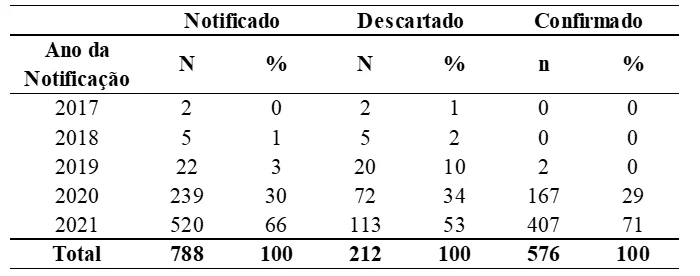
Regarding the notifications in the respective years, the sociodemographic information was described in Table 2. The male gender was predominant in all years, the brown race/color also had a growing and predominant behavior, and the age group younger than one year had a higher number notifications in general.
Table 2 – Gender, Race and Age Group of Measles Notifications from 2017 to 2021, Macapá, AP, Brazil
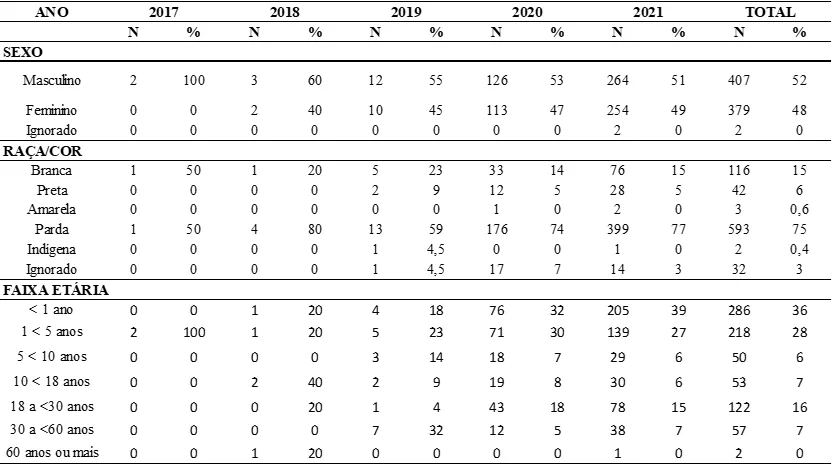
Table 3 presents the sociodemographic characteristics related to schooling and occupation. Regarding the period of study, the schooling that stood out was that which corresponds to incomplete primary education up to the 8th grade.
Table 3 – Schooling and Occupation in Measles Notifications from 2017 to 2021, Macapá, AP, Brazil
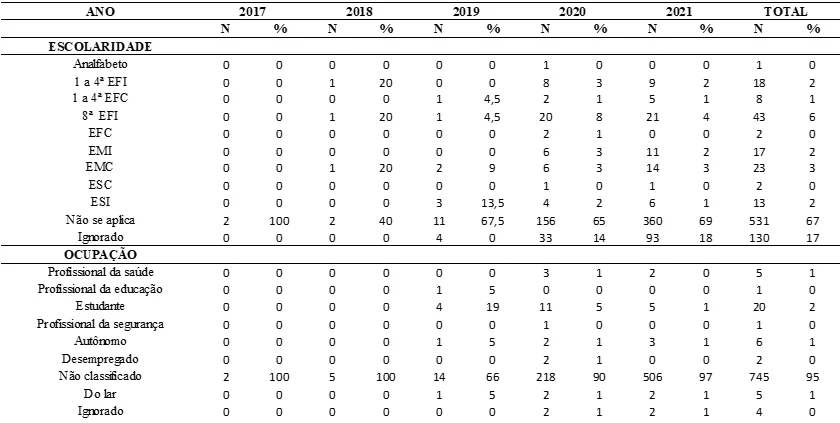
As for the demographic data related to the location and distribution of patients who were notified with measles, the investigated residential neighborhoods were divided by location into Zones, namely: North, South, Central, East and West Zone of the municipality of Macapá, being presented in the Table 4 only the confirmed cases of the disease. As for the Residential Area (rural or urban) and the Place of Contact, they were described according to the notification of suspected cases.
Table 4 – Area of the City of Macapá, Residential Area and Possible Contact of Contamination found in Measles Notifications from 2017 to 2021, Macapá, AP, Brazil
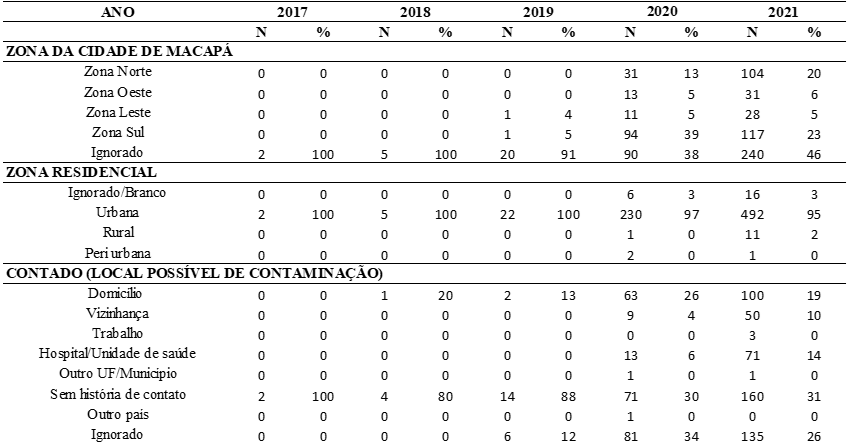
Among the clinical data, only one case of a pregnant woman was confirmed, who was in the 3rd trimester of 2020. Among the classic signs and symptoms, rash and fever were the predominant symptoms in the five years analyzed. Other symptoms found in the notifications are shown in Table 5, as well as the outcome of the evolution of the cases.
Table 5 – Signs and symptoms found in Measles Notifications from 2017 to 2021, Macapá, AP, Brazil
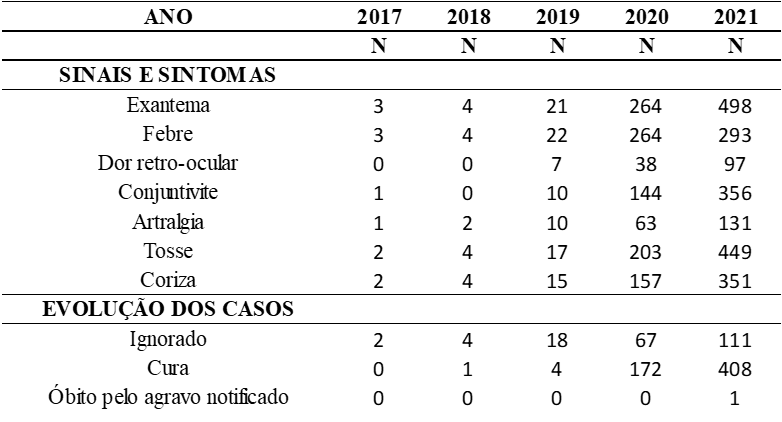
DISCUSSION
Regarding the reported cases (Table 1), it can be seen that the year 2021 was the period with the highest number of cases. The study by Amorin et al. (2022), corroborates this data when analyzing the resurgence of the disease in Brazil, as well as the epidemiological bulletin of the Sanitary Surveillance in the same year (2021), marks the year with the highest number of notifications and confirmed cases (BRASIL, 2021).
It can therefore be inferred that the year 2021, due to the period of the COVID19 pandemic, which led to the confinement of people in their homes due to isolation recommendations, favored the low demand for vaccines that protect against this disease, thus contributing to an increase in the susceptibility of these individuals to measles. According to Sato et al. (2023), a drop in the routine immunization of children during the pandemic can be observed, emphasizing that more than 27.2 million children did not receive the first dose against measles, which resulted in almost 9 million children not were vaccinated, which may have contributed to the high development of this infection previously eradicated in our country.
The State of Amapá, located in the North of Brazil, is the region with the least investments in relation to minimum social and economic needs, such as basic sanitation and qualified access to health services, compared to the rest of the country (FERRACIOLLI, MAGALHÃES, FERNANDES, 2020 ). This context tends to further favor the chance of being affected by measles, which is closely related to the lack of adequate conditions, such as good nutrition, lack of basic sanitation, low investment in health and education (GUIMARÃES et al., 2020).
In addition, the geographical barriers imposed in the region can make it difficult to access essential services, with homes and maritime transport in places far from the banks of rivers, the so-called riverside people, who are even more susceptible to these infections due to poor access to these basic conditions, such as lack of access to education and health services (JÚNIOR et al., 2020).
According to a case study carried out by Matos et al. (2022), the reasons that justify the low numbers of adherence on the part of the riverside people were related to the various refusals and the important resistance on the part of this population, which in the case of the vaccine against Covid-19, was linked to their cultural values and religious who are strongly involved in the life of these traditional peoples, with other factors being the scarcity and difficulty of information, their low income and lack of education, which presumably may also affect the low measles vaccination coverage.
Another more recent factor pointed out in the literature concerns the immigration process in Venezuela, intensified from 2018, which happened without a political and public health organization, with failure to offer the vaccine to immigrants (COSTA, BRANDÃO, OLIVEIRA, 2018 ).
According to Epidemiological Bulletin No. 13 2017/2018, Venezuela was facing an outbreak of measles at the time, with 9 of the 23 states having confirmed cases of the disease. At that time, 414 cases of measles were suspected in Roraima, 200 of which were confirmed, where 133 (66.5%) were Venezuelans, 65 (32.5%) Brazilians, 01 (0.5%) from Guyana and 01 (0.5%) from 5%) from Argentina (BRASIL, 2018). This condition may have contributed to the entry of new non-autochthonous cases into the country, and favored infection by this disease, especially in those individuals who were susceptible.
As for the sociodemographic characteristics of the notified population (Table 2), the predominant male gender corroborates the study by Ferraciolli, Magalhães and Fernandes (2020), which describes the low adherence of men to the health service, with greater vulnerability to diseases. It is also complemented that public policies for the inclusion of men in the health service are still little encouraged by government sectors, which contributes to the increase of cases in this genre.
The age group of less than one year had the highest number of notifications (Table 2), as well as in the study by Xavier et al. (2019). This can be explained by the fact that children are more susceptible to infections in the first years of life. Since adaptive immunity, responsible for immunological memory against antigens, is still in the process of maturation, reaching maturity only after the first decade of life. This may favor a greater propensity for contagion by pathogens that contribute as an important cause of infant mortality in low-income countries (XAVIER et al., 2019; OPAS, 2019; FERRACIOLLI, MAGALHÃES and FERNANDES, 2020; PINTO, SOUZA and ARANDA, 2020).
This study, by identifying the age of less than one year, opposes a national epidemiological study, in which the age most affected is currently the young population, as there is no vaccination booster, which shows that in the State of Amapá, adherence to childhood vaccination still it falls short of the goals established in the country (FERREIRA, et al. 2019).
In a study carried out by Rodrigues, et al. 2022, which evaluated the epidemiological and vaccination profile of suspected measles cases in the north of Minas Gerais, identified the self-declared brown race in 60% of suspected measles cases, followed by the white race with 31.43%. Linked to this, according to the 2010 Demographic Census carried out by the IBGE, the state of Amapá had a population composed of 62.5% of pardos. Which can corroborate the results of this research, which identified the brown race as the most affected in the city of Macapá.
As for schooling (Table 3), in relation to the period under study, there is a higher level of education corresponding to incomplete primary education up to the 8th grade, as well as occupation, most were identified as students (Table 3), this low level of education is pointed out by Sato (2018) as one of the main causes of low adherence to immunization and in a more current context, it contributes to the strengthening of false news on social networks on the internet about vaccination, by making it difficult to access and correctly interpret information ( CARVALHO et al., 2021).
In view of the high rate of ignored in schooling, it is important to emphasize the correct completion of the compulsory notification form. The notification of communicable diseases such as measles is the beginning for the adequate fight against the disease, its incorrect filling contributes to the lack of knowledge of the health-disease process, being essential for the planning and management of resources, consequently promoting and protecting the health of the population (MARQUES, SIQUEIRA, PORTUGAL, 2020).
Regarding the demographic characteristics of Measles notifications (Table 4), it is observed that the South Zone of the city of Macapá/AP is the most affected in an increasing way in the period from 2017 to 2021, as well as the greater identification of cases in the Urban Zone , it is reiterated that also for these data, there is a high rate of ignored, that is, incomplete filling of the data of the notified cases, hindering the quality of the investigation of the place of greater contagion. The identification of cases by area that this most affects, reinforces the need to understand the endemic and epidemic behavior of a region, thus being able to subsidize, in addition to other studies, public policies and investments such as intensification of vaccination coverage, since it demonstrates the places that there are greater susceptibility of the population (MOURA et al., 2018).
As for contagion, still in Table 4, the absence of contact history predominated in all years, as well as a case study carried out by Jesus et al. (2015), which emphasizes that the presence of febrile rash illness and reactive serology for measles should be treated as a confirmed case, with the contacts being quickly notified and investigated with a retrospective search of the cases, so that there is no delay in the investigation.
Regarding the clinical aspects, discussed in Table 5, the symptoms of fever and rash, are the most characteristic of the disease, as stated by Xavier et al. (2019). Measles has distinct phases, the last phase being the rash, and in this phase its transmission occurs both five days before and after the onset of the rash. With a 90% risk of new infections with people exposed to the transmitter, fever is a symptom three to four days before the exanthematous phase. It is important to note that the rash can make the diagnosis difficult, as it is a classic symptom common to other infectious diseases, mainly in the Amazon region (XAVIER et al. 2019).
Regarding the evolution, the highest outcome found in the cases was cure, as in the study by Makarenko et al. (2022), which guides the investigation of data on previous vaccination to understand this outcome, highlighting the importance of studies that address new cases and vaccine coverage of measles in Brazil.
For measles, its outcome is associated with low socioeconomic status, incomplete education, basic sanitation, inadequate personal and environmental hygiene, nutrition of greatest concern for children with malnutrition, access and self-care of a population (XAVIER et al., 2019).
New strategies are being taken to reverse the current scenario of measles resurgence in Brazil. A project authored by Bio-Manguinhos in 2021, aims to implement actions to support the National Immunization Program to reverse the low vaccination coverage, aiming to ensure the control of vaccine-preventable diseases such as measles, and points to the state of Amapá, as one of the places strategic plans aiming to collect information on the causes of low vaccination coverage in the period from 2015 to 2021 in the 16 municipalities of Amapá, including the city of Macapá.
FINAL CONSIDERATIONS
In addition to the socioeconomic risk factors of developing countries, and aggravated by the geographical difficulties of a municipality located in the extreme north of Brazil, the false sense of security due to the eradication of the disease in the past, the immigration process in a municipality on the border of Brazil, anti-vaccination movements, low vaccination coverage and the Coronavirus pandemic, added to the aggravation of new cases of measles that emerged after 2018.
Health promotion and disease prevention policies can be one of the ways to return high vaccination coverage, focusing on combating untrue information and reaffirming the importance of these strategies that are proven to be effective in combating various diseases.
The new projects that arise to promote the identification of possible causal factors of the new measles outbreaks that have appeared in Brazil, especially in Macapá, are a hope of controlling the current epidemiological reality related to this disease, mainly with the intention of resuming the status of vaccinations that helped the nation be considered a measles-free country.
REFERENCES
BRANCO, Victória Gabarron Castello; MORGADO, Flávio Eduardo Frony. O Surto de Sarampo e a situação vacinal no Brasil. Revista de Medicina de Família e Saúde Mental, Teresópolis, RJ, v.1, n.1, p. 74-88, 2019.
BRASIL. Ministério da Saúde. Situação dos casos de sarampo nos Estados de Roraima e Amazonas – 2018. Informe nº13 – 2017/2018, 2018. Disponível em: https://sbim.org.br/images/files/informe-n13-sarampo-cgdt-04-07-2018.pdf. Acesso em 24 fev. 2023.
_____. Ministério da Saúde. Vigilância Epidemiológica do sarampo no Brasil – semanas epidemiológicas 1 a 52 de 2021. Boletim Epidemiológico, Brasília, DF: Ministério da Saúde, v. 53, n.3, 2022.
CARVALHO, Walef Robert Ivo; et al. Impacto na baixa vacinação contra o Sarampo no cenário da Pandemia de Covid-19 no Brasil. 12° Congresso Paulista de Infectologia. The Brazilian Journal of Infectious Diseases, v.25, 2021.
DOMINGUES, Carla Magda Allan S; et al. A evolução do Sarampo no Brasil e a situação atual. IESUS, Brasília, DF, v.1, p. 8-19, 1997.
FERRACIOLLI, Giullia Bianca; MAGALHÃES, Brunna de Souza; FERNANDES, Weslei Lopes. A suscetibilidade do sarampo na região Norte do Brasil, no ano de 2014 a 2018. Revista Extensão, Palmas, TO, v.4, n.1, 2020.
FERREIRA, Ruan da Silva Barreto; et al. Correlação entre cobertura vacinal e notificações por sarampo no Distrito Federal. Reas/EJCH, v.11(17), 2019. Disponível em: https://acervomais.com.br/index.php/saude/article/view/1654. Acesso em: 20 jan. 2023.
GUIMARÃES, Ananias Facundes; et al. Acesso a serviços de saúde por ribeirinhos de um município no interior do estado do Amazonas, Brasil. Revista Eletrônica Pan Amazônica de Saúde, Ananindeua, PA, v.11 Disponível em http://scielo.iec.gov.br/scielo.php?script=sci_arttext&pid=S2176-62232020000100012&lng=pt&nrm=iso. Acesso em: 12 fev. de 2023.
IBGE- INSTITUTO BRASILEIRO DE GEOGRAFIA E ESTATÍSTICA. Censo demográfico 2010: Características gerais da população, religião e pessoas com deficiência. Pág 62-68, Censo demográfico, Rio de Janeiro 2010.
JESUS, Hiane Santos de; et al. Investigation of a measles outbreak in Pará State, Brazil, in the age of elimination of the disease. Cad. Saúde Pública, v.31 (10), 2015.
JÚNIOR, Adilson Mendes de Figueiredo; et al. O acesso aos serviços de saúde da população ribeirinha: um olhar sobre as dificuldades enfrentadas. Revista eletrônica Acervo Científico, v. 13 e 4680, 2020. Disponível em: https://acervomais.com.br/index.php/cientifico/article/view/4680. Acesso em: 12 fev 2023.
KAUARK, Fabiana da Silva; MANHÃES, Fernanda Castro; MEDEIROS, Carlos Henrique. Metodologia da Pesquisa: um guia prático, Bahia: Via Litterarum, Itabuna, 2010.
MARQUES, Carla Adriana; SIQUEIRA, Marluce Mechelli de; PORTUGAL, Flávia Batista. Avaliação da não completude das notificações compulsórias de dengue registradas por município de pequeno porte no Brasil. Ciência & Saúde Coletiva, Rio de Janeiro, RJ v.5, n.3, págs 891-900, 2020. Disponível em: https://cienciaesaudecoletiva.com.br/artigos/avaliacao-da-nao-completude-das-notificacoes-compulsorias-de-dengue-registradas-por-municipio-de-pequeno-porte-no-brasil/16920?id=16920 Acesso em: 10 de jan de 2023.
MATOS, Ruan Stefson Carvalho de; et al. Adesão das comunidades ribeirinhas a vacinação contra a Covid-19 no interior do Amazonas, Revista Eletrônica Acervo Saúde, Amazonas, v.15, n.3, 2022.
PEREIRA, João Pedro Campos; BRAGA, Gabrilele Maria; COSTA, Gabriela Araújo Negligência á Vacinação: O Retorno do Sarampo ao Brasil. Revista Científica de Saúde do Centro Universitário de Belo Horizonte, Belo Horizonte, v. 12, n.1, 2019. Disponível em: https://revistas.unibh.br/dcbas/article/view/2826. Acesso em 12 fev 2023.
PINTO, Maria Isabel de Moraes; SOUZA, Fabíola Suano; ARANDA, Carolina S; Sistema imunológico: desenvolvimento e aquisição da competência imunológica. Jornal de Pediatria, Rio de Janeiro, v. 97, pag. 59 -66, 2021.
RODRIGUES, Helena Regina Pinheiro; et al. Perfil epidemiológico e vacinal de casos suspeitos de sarampo em municípios da macrorregião de saúde norte de Minas Gerais, Brasil. Research, Society and Development, Vargem Grande Paulista, SP, v. 11, n. 12, 2022. Disponível em: https://rsdjournal.org/index.php/rsd/article/view/34113. Acesso em 12 fev 2023.
SATO, Ana Paula Sayuri. Qual a importância da hesitação vacinal na queda das coberturas vacinais no Brasil? Revista de Saúde Pública, São Paulov.52, n.29, 2018.
SATO, Ana Paula Sayuri; et al. Vacinação do sarampo no Brasil: onde estivemos e para onde vamos? Ciência &Saúde Coletiva, São Paulo, v.28 n.2 p.351-362, 2023.
VELASCO, Irineu Tadeu; et al. Medicina de emergência: abordagem prática, Barueri, SP: Manole, 14. ed., cap. 66, 2020.
XAVIER, Analúcia Rampazzo; et al. Diagnóstico clínico, laboratorial e profilático do sarampo no Brasil. J. Bras. Patol. Med. Lab, Rio de Janeiro, RJ, v.55, n.4, 2019.
APPENDIX – FOOTNOTE
9. Sistema de Informação de Agravos de Notificação (SINAN).
[1] Medical Student. ORCID: 0000-0002-2184-5008. Currículo Lattes: http://lattes.cnpq.br/9964172415042851.
[2] Medical student. ORCID: 0009-0002-9222-0256.
[3] Medical student. ORCID: 0009-0001-0051-3186.
[4] Medical Student. ORCID: 0009-0001-4005-5888.
[5] Biologist, PhD in Theory and Research of Behavior, Professor and researcher at the Instituto de Ensino Básico, Técnico e Tecnológico do Amapá (IFAP), the Programa de Pós Graduação em Educação Profissional e Tecnológica (PROFEPT IFAP) and the Programa de Pós Graduação em Biodiversidade e Biotecnologia da Rede BIONORTE (PPG-BIONORTE), Amapá hub. ORCID: 0000-0003-0840-6307. Currículo Lattes: http://lattes.cnpq.br/8303202339219096.
[6] PhD in Psychology and Clinical Psychoanalysis. Doctorate in progress in Communication and Semiotics at the Pontifícia Universidade Católica de São Paulo (PUC/SP). Master’s Degree in Religious Sciences from Universidade Presbiteriana Mackenzie. Master in Clinical Psychoanalysis. Degree in Biological Sciences. Degree in Theology. He has been working with Scientific Methodology (Research Method) for more than 15 years in Scientific Production Guidance for Master’s and Doctoral Students. Specialist in Market Research and Health Research. ORCID: 0000-0003-2952-4337. Currículo Lattes: http://lattes.cnpq.br/2008995647080248.
[7] Biologist, PhD in Tropical Diseases, Professor and researcher at the Physical Education Course at the Federal University of Pará (UFPA). ORCID: 0000-0001-8059-5902. Currículo Lattes: http://lattes.cnpq.br/1807260041420782.
[8] Advisor. Biomedical, PhD in Tropical Diseases, Professor and researcher at the Campus Macapá Medicine Course, Universidade Federal do Amapá (UNIFAP), and at the Programa de Pós-graduação em Ciências da Saúde (PPGCS UNIFAP), Pro-Rector of Research and Postgraduate Graduation (PROPESPG) from the Universidade Federal do Amapá (UNIFAP). ORCID: 0000-0001-5128-8903. Currículo Lattes: http://lattes.cnpq.br/9314252766209613.
Submitted: March 28, 2023.
Approved: April 15, 2023.
















